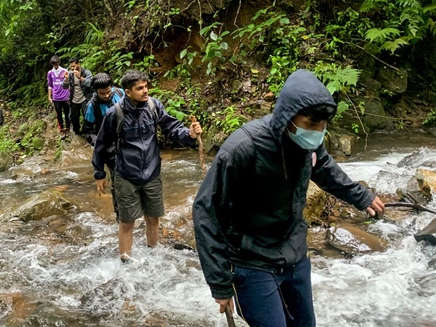Trek to Tranquility: Experience Peace and Adventure in Kudremukh


Nestled in the heart of the Western Ghats, Kudremukh—literally meaning “Horse Face” in Kannada due to the mountain’s distinctive shape—offers a unique blend of serenity and thrill that beckons nature lovers, trekkers, and solitude seekers alike. Located in Karnataka’s Chikkamagaluru district, this lesser-known gem is part of the Kudremukh National Park, a UNESCO-recognized biodiversity hotspot teeming with lush forests, rare wildlife, and breathtaking scenery.
In this article, we’ll guide you through the many dimensions of the Kudremukh trek, from practical planning tips to ecological significance, so you’re well-prepared to immerse yourself in both the tranquility and the challenge it promises.
Why Kudremukh is More Than Just a Trek
While the trek itself is undoubtedly exhilarating, the experience of Kudremukh is about far more than just reaching the summit. With rolling meadows, cloud-kissed peaks, and gurgling streams cutting through dense shola forests, the journey offers a sensory retreat into one of India’s most pristine natural environments.
The trail is dotted with unique flora and fauna. Birdwatchers often spot species like the Malabar whistling thrush and the great Indian hornbill, while lucky trekkers might catch a glimpse of the elusive lion-tailed macaque—a primate endemic to the region.
Kudremukh National Park is also a vital watershed area, with rivers such as the Tunga, Bhadra, and Nethravathi originating here. This ecological richness adds a deeper layer of appreciation for the environment you're exploring.
Planning Your Kudremukh Trek: What You Need to Know
Getting There:
Kudremukh is accessible from Mangalore (approx. 100 km) and Bangalore (about 330 km). Most trekkers start from Kalasa or Samse, small towns that serve as gateways to the trailhead. From there, a local jeep ride takes you to the forest checkpost where the actual trek begins.
Permits and Regulations:
Because the trek cuts through a protected forest area, you must obtain permission from the Forest Department. A limited number of trekkers are allowed each day to protect the ecosystem, so advance booking is essential. Guides are mandatory and often arranged through homestays or local trekking organizers.
Best Time to Visit:
The ideal window for trekking is October to February, when the post-monsoon freshness lingers, and the skies are generally clear. During the monsoon (June to September), the area receives heavy rainfall, making the trail slippery and prone to leech infestations. However, the landscape during this season is at its most vibrant and dramatic.
Trek Details: Distance, Difficulty, and Duration
The Kudremukh trek spans around 18 kilometers (round trip) and usually takes 6 to 8 hours to complete. Though not technically difficult, the trail is moderately strenuous due to its length and steep sections near the summit. A basic level of fitness and endurance is essential, especially if you're not an experienced trekker.
The trail begins with flat grasslands interspersed with streams, gradually transitioning into steeper inclines. What makes the hike particularly captivating is the ever-changing landscape—one moment you're in a mossy forest, the next, you're standing atop a sunlit ridge overlooking vast valleys.
Staying Amidst Nature: Homestays and Local Hospitality
One of the most endearing aspects of the Kudremukh experience is the warm hospitality offered by local homestays. Set amidst coffee estates and forest peripheries, these family-run accommodations provide simple but hearty meals and authentic local experiences. Staying here not only supports the regional economy but also connects you to the culture and stories of the place.
Some well-rated homestays include Bella Homestay, Mullodi Homestay, and Girikana Homestay. It’s advisable to book in advance, particularly on weekends or during peak seasons.
Environmental Responsibility: Tread Lightly
As with all ecologically sensitive areas, responsible trekking is paramount. Avoid carrying plastic, respect wildlife, and stick to designated trails to prevent soil erosion and damage to the forest floor. Trekking in small groups, following your guide’s instructions, and leaving no trace behind ensures that Kudremukh remains a haven for future explorers.
If you're traveling with a group, consider pooling resources to reduce your carbon footprint—shared transport, communal cooking equipment, and minimal waste practices go a long way in preserving the ecosystem.
What to Pack
Preparing for Kudremukh requires a balance between packing light and being equipped for unexpected conditions. Here's a quick checklist:
Trekking shoes with a good grip
Lightweight rain jacket or poncho (even in winter, mists are common) Reusable water bottles or hydration packs
Sunscreen and insect repellent
Energy snacks like trail mix or granola
Basic first aid kit
A small backpack (20- 30L)
ID proof and permit copies
Dress in quick-dry layers and avoid cotton, which retains moisture and can make you uncomfortable during long treks.
Beyond the Trek: Exploring Kudremukh’s Surroundings
While the trek is the centerpiece, Kudremukh has more to offer. You can visit Hanuman Gundi Falls, a secluded waterfall nestled in the forest, or explore Lakya Dam, once part of a mining area now being restored to its natural glory. Spiritual seekers often head to Horanadu’s Annapoorneshwari Temple, just 30 km away, for a moment of quiet reflection.
Combining the trek with a few days of local exploration can transform your trip into a wholesome retreat—an opportunity to not just escape the city but to rediscover stillness in nature’s embrace.
Final Thoughts
Trekking to Kudremukh is more than a physical adventure—it’s an invitation to reconnect with nature, rejuvenate your spirit, and immerse yourself in an untouched paradise. The journey offers moments of solitude, awe, and humility that are becoming increasingly rare in today’s fast-paced world.
Whether you're a seasoned hiker or a first-time trekker looking for a manageable yet fulfilling trail, Kudremukh delivers on every front. Just remember: the goal isn’t just to reach the summit—it’s to soak in the silence, savor the journey, and walk away with a renewed sense of peace.
Leave a comment